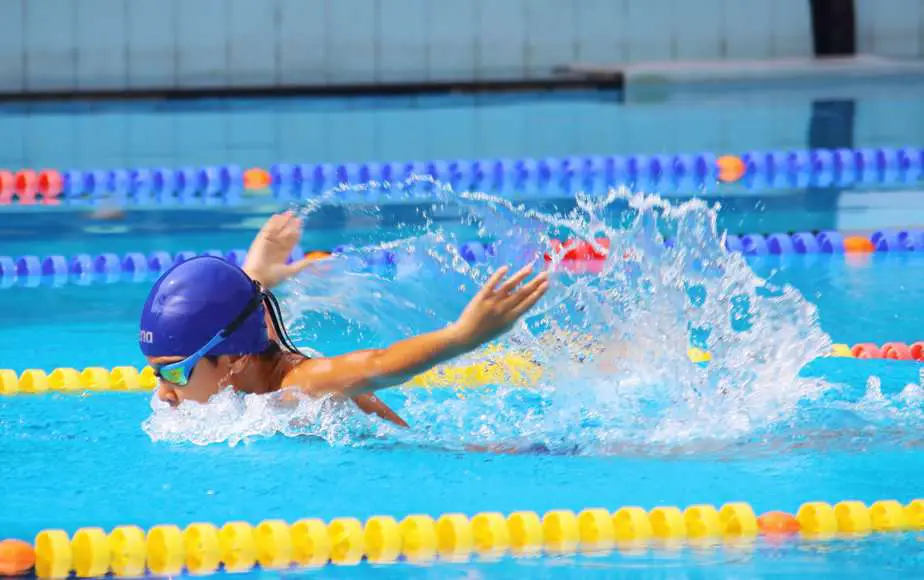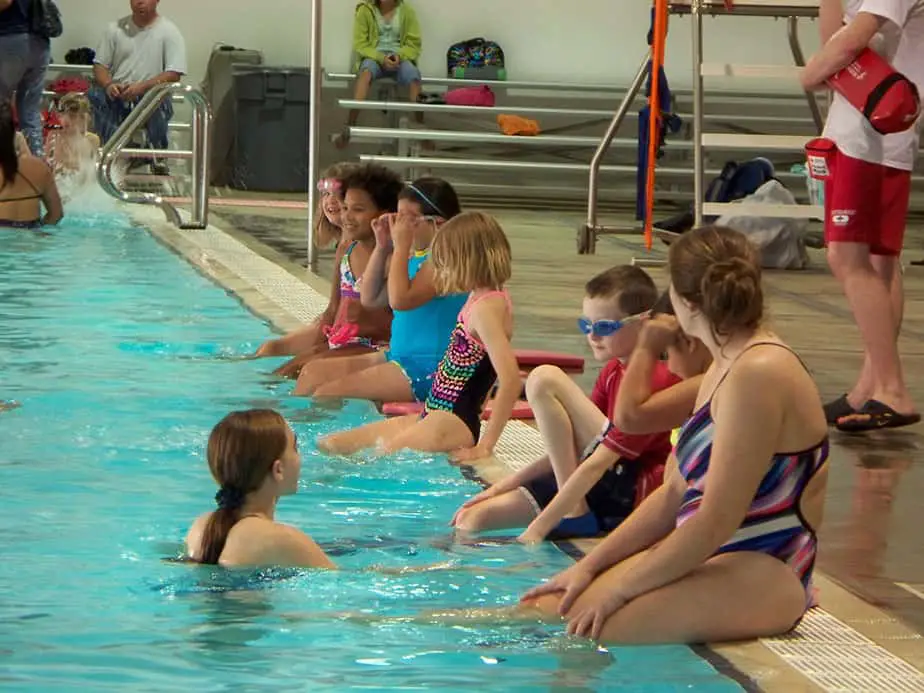If you’re looking to enroll your child into swimming lessons, a common question parents ask is how many lessons does it take? Is this going to be a significant investment in terms of time and money, or can it be easily and quickly done? The answers to these questions depend on numerous factors.
For one, what are your goals for your child? Is it just to learn basic water safety skills, or do you envision a future where s/he is a competitive swimmer? Even if there are no plans to go pro, there are still benefits to being a strong swimmer for recreational purposes such as surfing and kayaking in the future. Also, does your child have a fear of water? These factors will drastically change how many swimming lessons your child will require.
If the goal is simply to learn basic water safety skills, this can be taught in approximately a dozen or two swimming lessons. Keep in mind this is the bare minimum, and your child will still lack a lot of skills by the end of it. However, if your child is aiming to be a strong swimmer for competitive reasons or otherwise, s/he should take 2-3 lessons a week for as many years as it takes to hone his/her skills.
As you can see, there is not really a “minimum” amount of swimming lessons a child needs because each child’s skill and goals are different. However, there are certain tests that you can use to help gauge your child’s progress. If your child meets these requirements, then you can feel more confident letting them drop out of swimming lessons because s/he will have proved that s/he is proficient at swimming.
Read on to learn more about these factors and guidelines that help you determine when to stop swimming lessons for your child.
What are your goals?
It is a good idea to sign your kid up for swimming lessons. Even at an extremely young age, children should learn how to swim. According to the CDC, children ages 1-4 die from drowning more than any other cause of death except birth defects. For this reason, swimming lessons should start as early as 1 year old so that your child can learn basic water safety skills.
In accordance with these recommendations, many parents want their kids to at least learn basic water safety so that s/he can have peace of mind whenever their child is around a body of water.
However, some parents go even further beyond and want their children to be strong swimmers. If your child is a strong swimmer, then s/he can join the swim team and maybe one day become an Olympic athlete.
Even if there are no plans to go pro, being a strong swimmer opens up many opportunities in their life. Your child can take up other water sports as hobbies, including surfing, scuba diving, kayaking, canoeing, and so on. These sports all require strong swimming skills at a minimum, and will allow your child to enjoy life that much more.
Depending on your goals here, the time frame can be as short as a few months, or it can take years; it can be as short as a dozen or so lessons, or take hundreds of lessons to achieve these goals.
Is your child afraid of water?
A child who is afraid of water will take longer to learn how to swim because s/he first needs to overcome his/her fears. If your child is afraid of water, don’t worry. This is very common and thankfully most children overcome their fear quickly.
Most of the time their fear is not of the water itself, but rather the deep end of the pool or having their head completely submerged underwater. Something to note here is that children are not inherently afraid of water and even have innate reflexes that help them survive temporary submersion underwater.
Swim instructors who teach young children are aware that some are scared, and will work with each one individually to help them relax. A competent instructor will help your child overcome their fear and insecurities so that s/he can have the confidence to progress to the next lessons.
A child who is afraid of water to start with will require more lessons than one who has no fear of it. However, children can usually overcome this fear quickly, especially if the instructor is competent. That said, it is better to go slow and not force them so that s/he can have fun and not feel scared.
Learning basic water safety
According to the American Red Cross, it is important for everyone to be water competent for one’s own safety as well as the safety of others. You want your child to take enough lessons to be water competent.
They break down water competency into three components: water smarts, swimming skills, and helping others.
Being water smart requires you to know your limits and your physical condition, and to be able to recognize dangerous situations and how to avoid them.
As for swimming skills, the Red Cross recommends everyone to at least be capable of doing the following:
- Enter water that is above one’s head and be able to surface.
- Float or tread water for at least 1 minute continuously.
- Turn over and around in the water.
- Swim continuously for 25 yards.
- Exit the water without steps or a ladder.
To that end, your child will learn about sculling and survival strokes, as well as train their endurance to be able to perform these movements for as long as necessary.
Lastly, helping others requires one to keep an eye out for others who may be struggling in the water. If someone needs help, your child should call for help.
These are very reasonable expectations even for a young child. Within a dozen or so lessons, all of these criteria can be achieved, but more may be necessary depending on their aptitude.
Training to be a strong swimmer

Even after learning basic water safety skills, that does not make your child a strong swimmer. It only means s/he meets the minimum criteria needed to survive in calm waters such as the swimming pool, but what if s/he wants to swim elsewhere? If your child wants to swim outdoors or join the swim team, s/he will require more swimming lessons.
At some point, the lessons will move on from simply learning about water safety. Your child will need to learn about the various swim strokes and how to be proficient at them. The frequency of swimming lessons will also need to increase so that s/he can train enough to perform these movements proficiently.
Frequency matters
Two to three swimming lessons a week seems to be the sweet spot for kids to learn the proper techniques. Too frequent, and they may get overwhelmed and forget something. Too few, and they will also forget. That is why it is important to space out the swim lessons over the course of the week so that kids have time to digest what they have learned.
Furthermore, taking too many swim lessons can also make this otherwise fun activity into a tiring chore. Not all kids are thrilled to go to the pool. However, once they get the hang of it, they will hopefully enjoy the process a lot more.
Group or private lessons
Both group swimming lessons and private swimming lessons have their pros and cons.
Private lessons are more effective because your child will have one-on-one training with 100% of the teacher’s attention focused on him/her. The downsides are the cost and lack of socialization with other children.
Conversely, group lessons are not as effective per lesson because there will be periods of down time as the instructor has to shift his/her attention between multiple kids. If a child is disobedient on top of that, it can really slow down the lesson.
However, the benefit of group swimming lessons are the more affordable cost and the opportunity to interact with other children around their age. Group lessons are more popular simply due to the more affordable price.
Other factors
Each child learns at a different pace and so their needs differ as well. It is important to pay attention to their needs and bring your concerns to the swim instructor who will adjust the lessons as needed.
If your child has special needs or disabilities, s/he will take longer to become water safe compared to children without disabilities.
Another factor is their age and maturity level. As mentioned, parents are encouraged to enroll their children in swimming lessons at increasingly younger ages, even as young as 1 year old. During these early years of development, it can be harder for them to pay attention and stay focused.
Another consideration is maturity level. Some children are mature and obedient and others are more rambunctious. A rambunctious child will take longer to learn basic swimming skills compared to an obedient one.
Parting words
Depending on your goals for your child, the amount of swimming lessons needed to achieve these goals can be as few as a dozen lessons, or it could be hundreds over several years. If your child has not yet reached these goals, do not drop them out of swimming lessons early.
Most parents enroll their children in swimming lessons so that they can learn basic water safety skills. While it is impossible to make a child “drown proof”, swimming lessons have been shown to reduce drowning rates by up to 88% among children aged 1-19 years.
Other parents have even loftier goals for their children, such as a future in competitive swimming or the opportunity for their children to participate in more advanced water sports such as surfing and kayaking.
Whatever the case, it all starts with taking swimming lessons at a young age. We cannot guarantee that a child will become a strong swimmer in so few lessons, but at the very least it could help them survive a life-threatening event compared to if s/he had no swimming skills at all. Even a little bit goes a long way, so it will be one of the greatest investments you’ll ever make on your child.
Photo credit: abbamouse (CC BY-SA 2.0)


